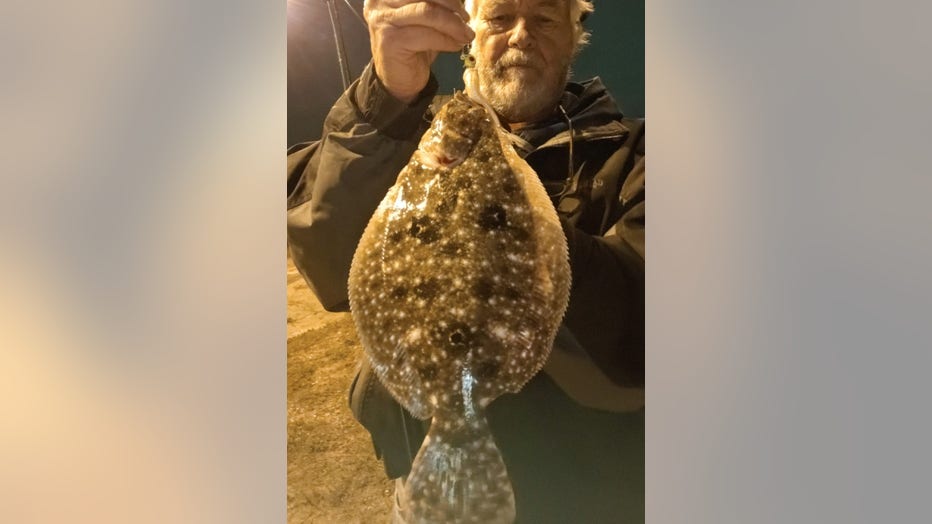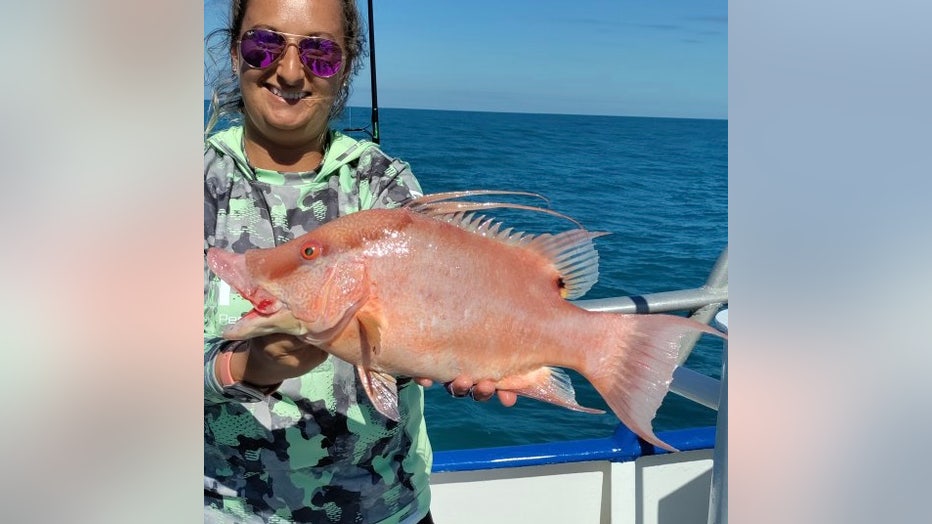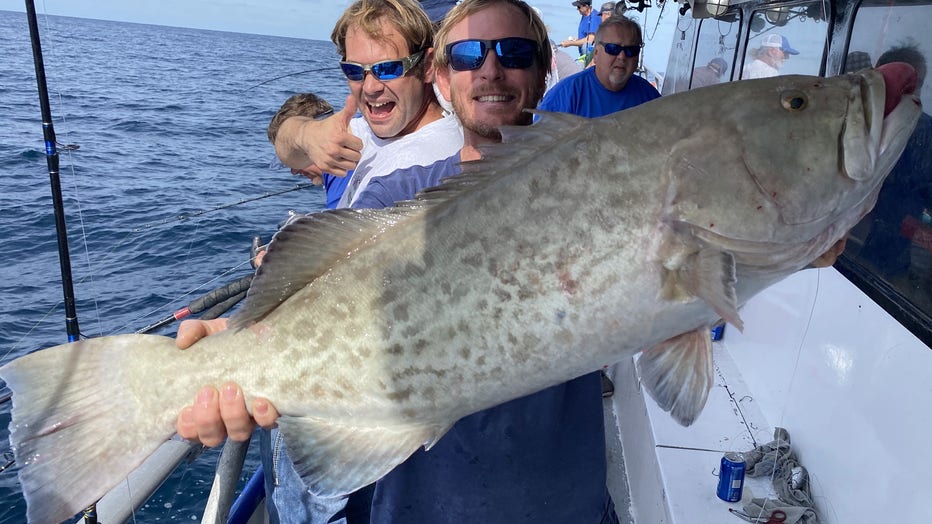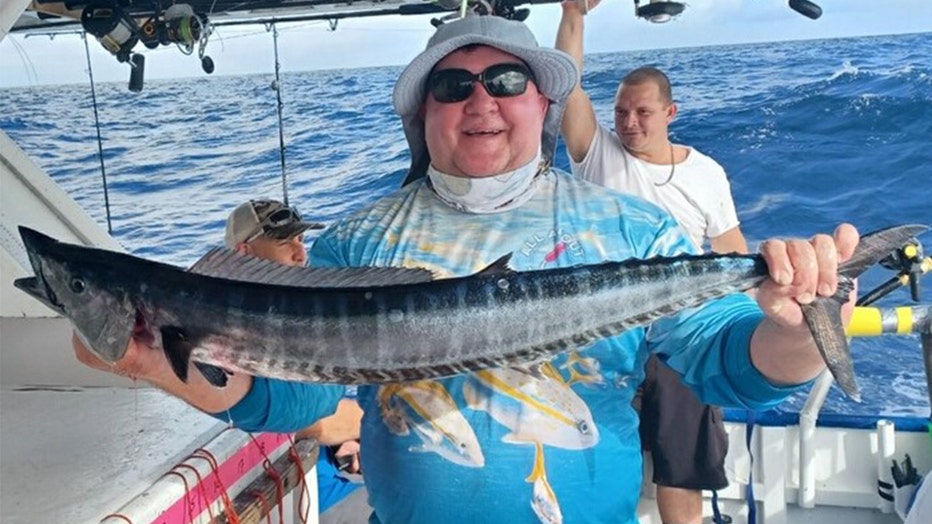Fishing Report: Nov. 5, 2021

Hogfish bite is picking up near shore
The hogfish bite seems to have gained some steam as of late. We are fishing a little deeper for them closer to 50-60ft of water, which seems to be the starting area, says Captain Dylan Hubbard of Hubbard?s Marina.
MADEIRA BEACH, Fla. - Every Friday morning, Captain Dylan Hubbard of Hubbard's Marina joins Good Day to fill viewers in on his fishing forecast as we head into the weekend.
Here is his fishing report for November 5, 2021.
Inshore
We have seen consecutive days now where there are no levels of red tide forecasted around Tampa Bay. Hopefully, this continues, and we can finally put to rest the red tide issues -- at least for the present time. Here is the latest forecast and levels from the USF and FWC collaborative efforts.
Sheepshead are biting better and better around the area. As cold fronts continue to barrage our area, that should only improve the sheepshead action around local docks, piers, bridges, and jetties. These guys love hanging around those areas of barnacles, oysters, clams, and other growth that will attract crabs, shrimp, and other crustaceans.
They will even cruise mangrove shorelines too! Lighter tackle, minimal weight, small hooks, and smaller chunks of bait is the best way to target these fish. However, they do have stiffer mouths, so a faster action rod and a J-hook with a solid hook set are important. Plus, when using smaller pieces of bait and fiddler crabs they come off the hook easily, so you must really get the ‘feel’ for the bait and bite.
Mangrove snapper are still around inshore too. So, in areas you are finding sheepshead, you will also have a shot to get after the mangroves too when using small pieces of shrimp. They will take the same tackle-and-approach of the sheepshead.
Redfish action has been good this past week -- still a little slower compared to August and early October -- but we are doing well, overall. There are still some schools of fish around, especially around the Upper Tampa Bay area. During the day, find those schools of mullet for feeding redfish. During the night, look for dock lights or bridge lights with sandier bottom areas. Fish the bottom with cut bait or slow-moving soft plastics for the redfish.

Redfish (Credit: Hubbard's Marina)
Snook action has surprisingly still been happening along our beaches and we’re still seeing some in the local passes too. However, most of the fish have moved back into the bay and there’s a good number of fish up in the bays and sounds on the flats. They are feeding well back on the flats during the day and around those mangrove shorelines.
Flounder action has picked up lately around those sandy patches in the flats, along the edges of the flats, and around local docks and bridges. They love the live shrimp, mud minnows, or slow-moving soft plastics. However, keep in mind they are right on the bottom, so your bait must be on or very near the bottom.

Flounder (Credit: Hubbard's Marina)
Pompano have been around the mouths of local passes, but with the red tide, it has been tough to find a good number of fish. Hopefully, now that we have cleaner, clear water around the area, between the fronts, we should hopefully see some good pompano action pick up before it gets too chilly.
Tripletail action has been great lately all around the bay, along the beaches, and even inshore and offshore! Virtually any floating debris, markers or buoys will be hiding a triple tail or three. We found a floating palm frond recently on our way offshore just off the beach -- with half a dozen nice tripletail under it!

Tripletail (Credit: Hubbard's Marina)
Near shore
Hogfish action has really picked up recently. We had a great trip Tuesday with over a dozen keeper hogfish and then Thursday we caught a handful too! The hogfish bite has been slowly picking up but seems to have gained some steam as of late.
We are fishing a little deeper for them closer to 50-60ft of water, which seems to be the starting area compared to 40ft due to the red tide blooms over summer. However, the same approaches are working best with around 30lb leader and a 4ot hook and about 1-2oz weights with live shrimp for bait.

Hogfish (Credit: Hubbard's Marina)
We are seeing some nice mangrove snapper near shore as well. However, the lane snapper bite is going extremely well but, unfortunately, they are still closed. Lanes should re-open soon, and we have heard that they could re-open mid-November to early December.
Besides the hogfish, mangroves – and plentiful grey snapper or white grunts – we have seen some nice scamp grouper near shore too, especially deeper near shore we have seen some good scamp around 60-100ft of water.
Mackerel and kingfish are around as well, and we are hoping that they get a bit more prolific and aggressive. Look for birds while near shore to find those bait schools that are being attacked by the mackerel and kingfish.
Offshore
Our short red snapper season extension ends today, November 5, but we still have tons of great eating fish to target offshore. The gag grouper bite has been so good lately, especially right before the fronts. We have seen plentiful gag grouper action here.

Gag grouper (Credit: Hubbard's Marina)
They are extra aggressive lately around those fronts right before and a few days following the front once the water calms down. Near shore, you must wait behind the front for the water to calm down and then clear up, but offshore you just need to wait for the waters to calm. Out deeper, the water does not get as stirred up with rougher weather like it does inside 100 feet of water. Big fronts will congregate the fish around larger structures and makes it easy to find good numbers of big gag grouper behind the bad weather.
Mangrove snapper action has been going well offshore too with a good number of fish mixed in on the ledges with big vermillions, porgies, almacos, and others. Plus, the yellowtail snapper action seems to continue to be steady around our area too. Now that red snapper season has closed, we will have more time to target these fun to catch mangrove snapper offshore.
Pelagic action has been nuts offshore lately with wahoo, tuna, kingfish, and the occasional sailfish around too. It’s a great time to remember trolling tackle while offshore beyond 120-140 feet of water.

Wahoo (Credit: Hubbard's Marina)
Trolling between bottom fishing areas is a great idea. For wahoo and big tuna and kings, the marauder-style lures -- like the Nomad Madmacs or Shimano Bonita lures -- are a great option. However, the lipped plugs like the Nomad DTX Minnows and the Rapala Xrap Magnums are a great all-around option.
For wahoo, the darker colors like purples, dark blues, and even some pink accents have been hot color patterns as of late.
DON’T BE A FOOL, bring a venting tool & descending device
Keep in mind the importance of dead discards and discard mortality when engaged in near shore or offshore fishing. How many do you know right now that are all for catching and releasing snook, redfish, and trout but will be the first in line to kill a mangrove snapper, gag grouper, or red snapper? But the attitude completely changes when discussing these offshore species?
Plus, the same person inshore that will hold their breath and wet their hands before handling a breeder snook will go offshore and then cull through 20 red snapper before keeping their two red snapper they deem large enough to fill their two-fish bag limits. Meanwhile, the other 18 they released will often end up suffering fatal damage if not properly descended or vented?
Please help us to spread the word on the importance of descending or venting your released fish. Descending devices are most easy to use and quick to pick up on their use. They are most effective for most anglers.
However, an expert and precise angler with proper training and tons of experience can use a venting tool properly with similar outcomes. A venting tool requires you to pierce the fish while most descending devices are much less invasive. While using a venting tool, it is imperative you pierce them in the exact right spot, and you do not go but a quarter-inch or less in the fish. Most venting tools require you to ‘choke up’ on the tool to prevent over-penetration into major organs.
When fishing deep water, especially in the hot summer months, please make sure to treat all fish intended to be released like that breeder snook inshore and minimize the time it takes you to get him from the bottom to the boat using heavier proper tackle, not an ultra-light spinning reel.
Then once onboard, minimize the time out of the water. Then use a proper de-hooking tool and then, for the love of God, use a descending device or venting tool PROPERLY to ensure that fish has a chance to live another day.
Three things will help ensure the survivability of those fish released offshore:
- Making sure they are brought up quickly and do not expend all their energy in the fight.
- Make sure they are unhooked smoothly, easily, and as quickly as possible.
- Finally, make sure they spend the least amount of time at the surface at negative pressures where barotrauma exponentially increases its effect with each passing second.
Also, keep in mind when the water is warm, there is less dissolved oxygen content and the chances of barotrauma increase even more while its effects can be even more deadly.
LINK: Here’s all the information and more on barotrauma and how to mitigate that fatal damage to your future offshore catch
**Note: I recommend the Salt Strong articles at the bottom of the page under ‘webpages.’ I helped them develop those personally.
STATE SURVEY to improve recreational data and access
It is imperative that you have your Gulf Reef Fish survey endorsement on your fishing license.
You should get one if you are a private recreational angler or diver fishing from a private boat anywhere in Florida who intends to harvest, attempt to harvest or possess one or more of the following reef fish species: mutton snapper, yellowtail snapper, hogfish, red snapper, vermilion snapper, gag grouper, red grouper, black grouper, greater amberjack, lesser amberjack, banded rudderfish, almaco jack, gray triggerfish, Gag grouper, Red grouper, Scamp grouper, Mangrove snapper, Lane snapper, Kingfish, Tuna, or Mahi mahi.
Here is all the information and more on that program and how you can sign up.
TERMS OF REFERENCE:
INSHORE – from the back bays out to the bridges and including right on the beaches
NEAR SHORE – From the beaches out to 20 miles, or up to 100ft of water
OFFSHORE – from 20 miles or 100ft and beyond
For more fishing reports, photos, videos and more check out Hubbard’s Marina on Facebook, Instagram, YouTube, or Snapchat. Just simply search "HubbardsMarina" and do not forget our family motto, "If you’re too busy to go fishing, you’re just too busy!

